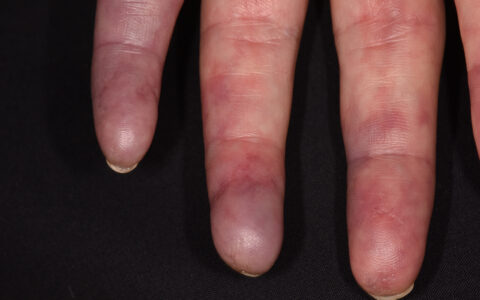Researchers at Vanderbilt University Medical Center have evaluated the effectiveness of two types of risk scores in identifying cases of systemic lupus erythematosus (SLE), a move designed to overcome diagnostic challenges and reduce time to treatment.
The research team, led by April Barnado, M.D., an assistant professor in the Division of Rheumatology and Immunology at Vanderbilt, examined a phenotype risk score (PheRS), created using EHR billing codes that capture disease criteria, alongside a genetic risk score containing 58 single nucleotide polymorphisms associated with SLE.
“With a phenotype risk score, the computer could pull together the various billing codes and see patterns that could potentially indicate lupus.”
According to their findings, genetic risks did not add clinical value beyond that provided by the phenotype risk score.
“For our EHR-based studies, the PheRS is likely to remain the focus,” Barnardo said. “Genetic data can be costly and is not always easy to obtain, and there are ethical and privacy considerations.”
Examining risk scores is one way to potentially shorten the convoluted path to confirming a lupus case, which can cause years-long treatment delays and lead to potentially serious tissue damage. The confusion also often increases patient anxiety and distrust of the medical system, say the researchers.
“The symptoms of SLE can resemble other conditions, and SLE patients also present in diverse ways, making it harder for providers to definitively recognize the disease,” Barnardo said. “SLE patients may become lost in the diagnostic odyssey of the health care system.”
The “fragmentary” nature of health care can make SLE symptoms hard to pin down, she added.
“A patient may first see primary care, or an orthopedist for joint complaints, or an ophthalmologist, so the symptoms may not initially be put together,” Barnardo said.
“With a phenotype risk score, the computer could pull together the various billing codes and see patterns that could potentially indicate lupus.”
Risk Criteria Assessed
Using the de-identified Synthetic Derivative database of clinical information from Vanderbilt’s EHR, Barnardo, corresponding author of the study, and her colleagues identified 789 SLE cases and 2,261 controls.
They built the phenotype risk score using EHR billing codes that capture disease criteria as defined by the American College of Rheumatology and developed a genetic risk score containing 58 single nucleotide polymorphisms associated with SLE.
The researchers analyzed the data to look for associations between the risk scores and lupus case status or diagnoses.
“One piece is looking at patients who were labeled as controls – meaning they didn’t have billing codes for autoimmune diseases – to see if there are undiagnosed lupus cases and, if so, how strongly those cases would be associated with higher risk scores,” Barnado said. “Another piece is looking at association of phenotype and genetic risk scores with lupus case status.”
Analyzing Control Groups
Their review of SLE cases showed a significantly higher phenotype risk scores than those of control participants. Additionally, control participants with the highest scores were found to have undiagnosed SLE.
Found among the GRS control participants were cases of incomplete lupus, in which patients did not meet all diagnostic criteria but had some of its features and may receive treatment for lupus. Such cases were also found in control participants with the highest PheRS.
Cases of other autoimmune diseases such as rheumatoid arthritis and Sjögren syndrome were also present in the control group, Barnado said.
Limits of Genetic Scoring
The researchers found that genetic risk scoring was only of limited utility in SLE cases, especially involving Black patients. They say more work is needed to understand the genetic risks of SLE in diverse populations.
“When you build a genetic risk score, you look at genome-wide association studies in the literature,” Barnado said. “Almost all such studies about lupus involve primarily patients of European or Asian ancestry. It’s likely that African Americans have race-specific risk loci for lupus, and we’re just not capturing those risk loci in our score.”
In addition, the heritability of SLE has been reported as around 30 percent.
“Certainly, genetics is not the full story in developing lupus,” Barnado said. “There are environmental and epigenetic influences.”
Expanding PheRS Applications
Barnado said she is looking toward potential expanded practical applications, with continuing research to point the way forward.
“The PheRS is built entirely from billing codes, which are readily available. There is the potential of deploying the PheRS in the EPIC EHR system in real time to capture known lupus patients, as well as undiagnosed cases in a larger patient population.”




